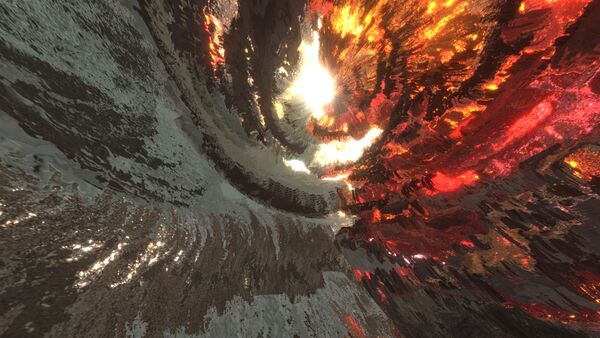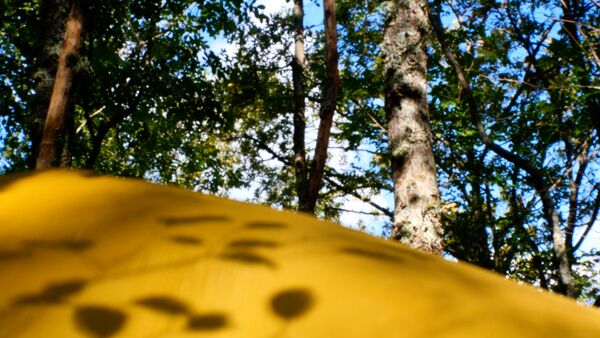Link2Methods
what how why
Myein
'Myein' is an A/V and dance performance that traverses different temporalities and narrative levels about the mediatic use of images, approached through Riccardo Santalucia’s audiovisual composition and Gloria Dorliguzzo choreography. The performance features photographies of the Early Netherlandish paintings as a source material to rethink our relation with past iconographies and aesthetics. By reinterpreting these images through modern image-processing techniques, the artists intention is to set a visual journey that challenges national mytholigies and activates procecces of cultural reterritorialization.
The approach here is radically punk but well-crafted: the artworks from the get digitally reinvented, even torned. Starting from their colours, it is as if a geological time-lapse guided us through different climatic eras. First we see the earth covered in eruption, then its deep freeze. The performer seeks ritual gestures able to craft a meaning for the nowness, but we don’t know whether it discovers a blessing or a witchcraft. Through different forms of acceleration and deceleration, conceived as a score of images, sounds and gestures, viewers are accompanied in a journey where the idea of becoming part of a fluid body arises, abandoning figurativeness and fixed symbologies.
As all around we sample and archive reality through technological means, and as we detach physical involvement in the experience of our history and reality, what uses can we make of these data collections? Are they just food for AI? Seeking answers to these questions, Riccardo Santalucia developed a personal coding practice to sample images and displace and shapeshift them retaining their color details. It's approach goes beyond a documentaristic or archive-like approah, toward a more personal reading of where images can bring us and what is their meaning for us today. The presence of a performer here is meant to accompany the audience toward the virtual realm unfolded by the video, while experimenting possible relations between the physical precence and the moving image.
––––––––
No Flag No Wind
‘No Flags No Wind’ is a lecture-performance composed of Riccardo Santalucia's theory- and practice-based research on the pratice of flag waving. The performance is composed of live actions, listening sessions, robot prototypes and collective excercise, resulting in an audiovisual and poetic essay on the use of our hands, their electrical prostheses and human obsolescence.
It all starts with flags. Whether they are choreographic instruments or tools for live-tracking the movement of the breeze, in this context flags become narrative devices. Within them, different media, swarms of drones that acts as robotic flag-wavers, experimental animation, electromagnetic field recordings and fanfare rhythms meet to explore and speculate on the progressive lost of human agency due to automated systems.
Following his experience as an apprentice flag-thrower in the flag-throwing group of Sansepolcro (IT), the artist began to invent new possible relationships between flags and wind, hacking their signalling and symbolic properties. At first he was struck by the celebrative and communitu binding strenght of this practice altogether with the proudness expressed by the flag wavers and the corehographu of textiles. Secondly, he was fascinated by how fictional the history of flag wavers came to be, entangled between touristic, military and religious origins.
Interview
Dominique: What are you making?
Riccardo: I am now making a project called ‘Becoming Invisible’, based on an esoteric yoga excercise as described by the artist Ian Whittlesea. It is a short movie where I propose to become invisible through imagination, observation, breathing and the manipulation of the seven colors of the spectrum.
Dominique: Why are you making it?
Riccardo: The moment I saw the title of this exercise book, I first connected it to privacy culture: where our data goes, how we are observed, who is observing us, how we give a lot of information about ourselves and all these related topics about security. Becoming invisible sounded to me like a hack you can obtain, so a magician who can cast spells. What do you gain from it? The exercise says that you do not disappear, you are still present, but you are somehow unobservable because you cast a light. Becoming invisible through the camera lens overexposure. Discovering its content, It recalled to my mind a guided exercise that my mother accompanied me into when I was 14, where with my imagination I would breathe colors and channel them through my own body. I remember it to be very relaxing, my muscles and bones reacting differently to different colors. It fascinated me to just think: “okay let's try to translate this book, which is short, it has few pages, on the left side you have text, on the right side usually you have a color, in a visual exercise”. Very soon, as I was relating with these colors, I started to imagine different possible paths to follow, discovering bridges and connections that can come together, but then I decided to focus on the visual translation of this exercise. Making a short movie out of it is quite a challenge because it really takes some time to make this exercise and I'm realizing that by shrinking it, something else happens. If at first the aim seems to be to enter a meditative state, now I'm starting to understand how I can change the way of accessing this experience into a more visual one, and still convey this impression of what you can achieve being exposed to color, what you can achieve with your imagination and why would you become invisible.
Dominique: How is it different from your previous works?
Riccardo: Yeah for sure I would say in term of speed because in my other projects usually there is a fast pace of moments in succession, very dramatic in a way that the use of color creates tensions and crescendo has a big impact. Also in other works I did I had different layers of concepts, like ‘Myein’ it is about the Early Netherlandish Paintings and how we can access them through digital means, how they are connected to national affirmation and what kind of social view they cast forth. These different layers reflect the way that the project itself is delivered to the audience, as an installation with a quadraphonic system and a live dance performance. In this case it's only video, it is short, there are no human actors, it's only text, colors and sounds, and I found it very thrilling to challenge the audience with simple yet engaging actions, where your own experience becomes a great part of what is going on. On the other hand, having an unrealistic yet charming objective as the one of becoming invisible, seems to me a very nice way to relate with privacy concerns: what is meant to be private and what is accepted in public?
Dominique: What are the most significant choices you made?
Riccardo: As I said before a significant choice regards the rhythm and the choice to do not overlay too many meanings and conceptual layers but actually to do something that is simple, and more than simple, something that gives space for the audience to act, you are not just feeded with images, finding yourself to be pulled, as if you are a guest on an airplane and you can have a coffee meanwhile, your presence and activity are requested. Also, this exercise is delivered through a text displayed on the screen. This means that there is no sexual characterization, but you hear a inner voice designed by yourself.
Dominique: What questions does it ask?
Riccardo: It asks to be engaged and to be generous, because as it is a tutorial, it needs you to be active. Also it opens questions on how you feel colors. Can you imagine colors? How do you react to this colors?
Dominique: Do you think that there is a connection between colors and psychology?
Riccardo: In this context rather than psychology, I found it interesting how you can feel colors physically. As I said, trying the exercise myself, I could feel different parts of my body reacting to different colors. More than associating colors with fixed meaning, I rather understand them as a force field able to manifest different emotions based on the observer's own inner state. Therefore, they can reflect on your needs and desires.


